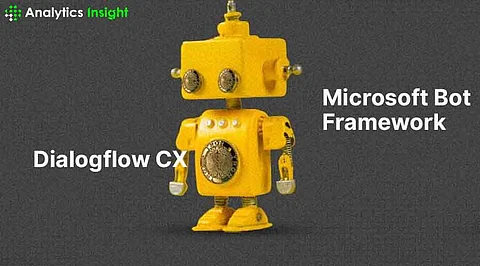

The conversational AI market is growing rapidly. The global chatbot market is projected to reach $1.3 billion by 2025, up from $190 million in 2020, according to the Markets and Markets report. Two leading platforms, Dialogflow CX and Microsoft Bot Framework, enable developers to build intelligent conversational interfaces. In this article, we'll compare these platforms to help you choose the best fit for your needs.
Dialogflow CX and Microsoft Bot Framework both platforms offer robust solutions for building conversational AI. However, they cater to slightly different user needs, making the choice highly dependent on your organization's requirements. This article will showcase the distinction between the two allowing it to be a rite of passage for making the right choice according to individual needs.
Dialogflow CX, formerly known as Google Cloud Dialogflow, is a Google-developed platform for building conversational interfaces. It supports text and voice-based interactions, integrating with Google Assistant, Google Cloud Speech-to-Text, and other Google services. Microsoft Bot Framework, on the other hand, is an open-source platform for building conversational AI solutions. It supports various channels, including Microsoft Teams, Skype, and Slack.
1. It is developed by Google and is particularly user-friendly for those with limited technical expertise.
2. It supports over 20 languages and allows users to create chatbots with little to no coding.
3. It excels in natural language processing (NLP) and offers seamless integration with Google services like Google Assistant, along with other platforms such as Facebook Messenger and Twitter.
1. Developed by Microsoft, Bot Framework offers a more developer-centric approach, with flexibility through BotBuilder SDKs and Azure integrations like LUIS (Language Understanding) and QNAMaker.
2. It's ideal for creating highly customizable bots that can be deployed across various platforms, including Skype, Cortana, Kik, and Telegram.
3. The framework supports about 15 languages, which is slightly less than Dialogflow’s language support.
4. It is more flexible but might require higher technical expertise, particularly for setting up and scaling complex bot solutions.
Tight Integration with Google Services: Dialogflow CX seamlessly integrates with Google Cloud Services, making it ideal for developers already invested in the Google ecosystem. With this integration network in place, it provides native support for Google Cloud, Google Assistant, and other messaging platforms.
Advanced NLP Capabilities: Dialogflow CX's integrated Google NLP provides superior intent recognition and entity extraction. The platform is designed to handle complex conversations, making it suitable for customer support, virtual assistants, and interactive voice response (IVR) systems.
Scalability: Dialogflow CX can handle volumes of conversations with ease. While excellent for small to medium-sized projects, may require custom development for more complex needs, especially if you need to build custom user interfaces or integrate with non-Google platforms.
1. Cross-Platform Support: Microsoft Bot Framework supports various channels, making it suitable for enterprises with diverse communication platforms. It stands out with its integrations across Azure services, such as Cognitive Services, which allow for more advanced AI capabilities like sentiment analysis and custom natural language understanding models.
2. Open-Source: Microsoft Bot Framework's open-source nature allows for customization and community-driven innovation. It's ideal for creating highly customizable bots that can be deployed across various platforms, including Skype, Cortana, Kik, and Telegram.
3. Integration with Microsoft Azure: Tight integration with Microsoft Azure services simplifies development and deployment. For businesses already using Microsoft products, Azure Bot Service can be more efficient, as it seamlessly integrates with Microsoft Teams, Office 365, and Power Automate.
1. Domino's Pizza: Uses Dialogflow CX for voice-based ordering, resulting in a 25% increase in sales.
2. American Airlines: Implemented Dialogflow CX for customer support, reducing response times by 30%
1. McDonald’s: Built a chatbot using Microsoft Bot Framework, engaging 1 million users within the first month. It is also used for the practical implementation of AI in all McDonald's China locations.
2. Chanel: Uses Microsoft Bot Framework for customer support, resolving 30% of issues without human intervention.
According to TrustRadius ratings, Dialogflow CX scores slightly higher in usability (8.9 vs. 8.8 for Azure Bot Service), reflecting its ease of use for non-developers. However, Microsoft’s Bot Framework is favoured for more extensive developer tools and customization options, especially when advanced AI services are required.
Choosing between Dialogflow CX and Microsoft Bot Framework ultimately comes down to your specific requirements. If you need a platform that is easier to use, requires minimal coding, and integrates well with Google products, Dialogflow CX may be the better choice. It is especially suited for small to medium-sized businesses or those looking for rapid deployment of chatbots across multiple platforms.
Conversely, if your organization is already heavily invested in Microsoft's ecosystem or you need greater customization and integration with advanced AI services, the Microsoft Bot Framework provides a more flexible and scalable solution. It is ideal for enterprises or businesses looking to build complex, feature-rich bots. Both platforms are excellent choices, and your decision should be based on factors like team skill level, existing infrastructure, and long-term scalability requirements.
